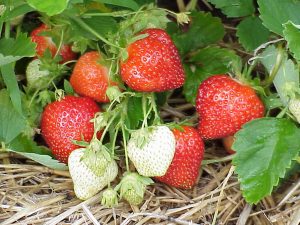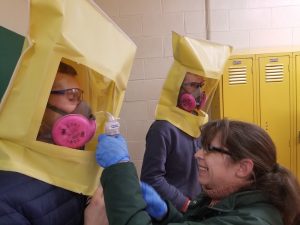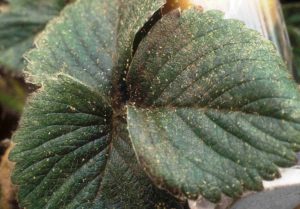Strawberry IPM Newsletter No. 2 – May 31, 2019

Strawberry IPM Newsletter No. 2 – May 31, 2019
Click on photos to enlarge.
BLOOM (FINALLY) UNDERWAY IN STRAWBERRY FIELDS
Time to Protect Blossoms from Gray Mold Infection
Berry Growers Twilight Meeting
Thursday, June 6, 2019 at 5:00 p.m.
Maxwell’s Farm, Cape Elizabeth, Maine
Situation:
More rain and cold weather over much of the last two weeks continues to slow strawberry development, but we are now seeing early varieties and plants that were under row covers coming into bloom. Winter damage is evident in many fields, especially where water settled and froze, incasing plants in a thick layer of ice. Many growers have applied their first fungicide application for gray mold. Once spray materials have dried on the plants, they are generally considered “rainfast”, unless there is more than one inch of rainfall. Once more than one inch of rain has fallen, or there has been significant shoot or flower growth that is unprotected since the last application, another fungicide application should be applied to assure adequate protection. Remember to alternate fungicide and insecticide chemical families to prevent the development of pest resistance.

Twilight Meeting Thursday June 6th at Maxwell’s Farm Strawberry Fields, Bowery Beach Road, Cape Elizabeth. The fields are between the entrance to Crescent Beach State Park and the Inn by the Sea. Bill and Lois Bamford will discuss their strawberry production on this site by the ocean, bordered by beaches, tourist sites and wealthy estates. The berries are marketed through U-pick sales and local markets. We will also get an update on the berry pest situation around the state, and have an opportunity to look over the equipment they use for their operation. The meeting will run from 5:00 p.m. to 7:00 p.m. Two pesticide applicator recertification credits will be awarded for attending the meeting. There will also be a Respirator Fit Test available. Please contact Lisa Turner at lisa@laughingstockfarm.com to preregister for the fit test. See you there!
Strawberry bud weevil or “clipper”: With bloom getting underway, it is time for clipper damage to start appearing. Activity has been very low in fields that we’ve scouted this week, with none over the control threshold and only a few indications of feeding injury in all of the fields. The threshold for injury is more than 1.2 clipped buds per two feet of row. Small holes in the petals of opening flowers can indicate clipper feeding activity, and is often first noticed in the border rows. Expect clipper damage to increase as temperatures warm and later blooming varieties come into bloom. Insecticide options for clipper include Lorsban®, Brigade®, Bifenture®, Danitol®, Sevin® and PyGanic®. Clippers will also attack the buds of raspberries and blackberries, although they do not usually cause significant injury.
Tarnished plant bug activity has also been very low this week, likely slowed by the cool, wet weather. So far, only one soggy, early instar nymph has been found in s southern field. The nymphs can be hard to find, especially if the plants are wet. Young nymphs are very small (2 mm), active, yellow-green insects. It is important to scout for them regularly, as they can appear very quickly once the weather improves. The threshold for nymphs is 4 or more flower clusters infested per 30 sampled. Start scouting any field with open flowers now. Insecticide options for tarnished plant bug include malathion, Assail®, Brigade®, Bifenture®, Dibrom®, Danitol®, and PyGanic®.

Two-spotted spider mites: Cool, wet weather is not conducive to spider mite infestations, but we did find a few mites and eggs on strawberry plants that had been under row covers this winter/spring. These cases were well under threshold, so no control measures have been recommended at this point. Once temperatures become warmer we may see more problems with mites. It is important to scout for them regularly. If 25% of leaves sampled (e.g. 15 out of 60) have any mites, a spray should be applied. Chemical control options for two-spotted spider mites include Acramite®, Savey®, Zeal®, Portal®, Vendex®, Oberon®, Brigade®, and Danitol®.
Cyclamen mites: Although we have not seen any indications of cyclamen mite injury this week, reports of infestations from other New England states suggest that we should be on the lookout for this pest. Heavily infested plants show weak growth and shrunken, crinkled leaves. These mites are very small and reside in the crown of the strawberry plant, feeding on the developing leaves and flower buds. They are very hard to see, even with magnification. Portal® can be effective, but must be applied in lots of water to be sure that the material is carried down into the crowns where these mites reside.

Diseases: As the fields come into bloom it is important to protect the flowers against infection by spores of the gray mold fungus, Botrytis cinerea. Most fruit infections take place through the flowers, so control efforts should be focused on the bloom period. Two to three sprays of fungicide are typically required to provide good protection. The first spray is usually applied at 5-10% bloom, followed by a second application at petal fall. Additional applications may be applied if there is significant rainfall between or following these two sprays.
Leaf spot is a fungal disease characterized by small purple spots with white centers on the leaves. The symptoms are often first visible on the older, lower leaves but often spread throughout the foliage. We’ve seen some leaf spot in most fields we’ve scouted this spring. Varieties vary quite a bit in susceptibility. If you see leaf spot in your field, you should consider using a fungicide that will provide control as part of your spray program for gray mold. Products such as Captan®, Luna Sensation®, Mervion® and Pristine® have activity on both diseases.
Leather rot (Phytopthora cactorum) may become a problem in fields where standing water is common during bloom and fruit development, especially if the fields were not mulched last fall. Incidence of leather rot can be reduced by applying straw mulch between the rows to prevent berries from touching the soil and reducing soil splashing onto the berries. Foliar sprays of Aliette®, Prophyt® or Phostrol® may be applied during bloom and fruit development to prevent leather rot.
Other Berries: Highbush blueberries are showing varying degrees of winter injury around the state, ranging from severe to moderate. If you’re pruning out winter killed branches now, you should sterilize pruning blades as you move from bush to bush with a mild bleach or alcohol solution to reduce the potential for spreading fungal diseases such as Phomopsis. You should also consider applying a fungicide such as captan or Pristine® once the pruning is done to reduce the chance of infections entering the wound sites. Mummy berry shoot strikes are also evident on bushes that survived the winter. The recent weather has been very favorable for mummy berry development, so growers should be applying appropriate fungicides to protect against this disease. Registered materials include Orbit®, Indar®, and Quilt Xcel®. See the New England Small Fruit Management Guide for details.
Raspberry canes are also show varying levels of winter injury, but most have at least some bud death. More injury will likely become evident in the coming weeks as the fruiting laterals on the canes start to elongate and flower, only to suddenly wilt and die. This delayed injury is due to the inability of the damaged vascular system to support this additional growth, especially as the weather gets hotter and drier.
The 2019-2020 edition of the New England Small Fruit Management Guide is now available. Members of the Maine Vegetable & Small Fruit Growers Association will be receiving a copy soon. If you would like to purchase a copy please contact Pam St. Peter at pamela.stpeter@maine.edu or the Highmoor Farm address below. Copies are $15 each. You can also access the guide on the UMass Cooperative Extension website.
Sincerely,
David T. Handley
Vegetable and Small Fruit Specialist
Highmoor Farm UMaine Extension Diagnostic
P.O. Box 179 Research Lab, Pest Mgmt. Unit
52 U.S. Route 202 17 Godfrey Drive
Monmouth, ME 04259 Orono, ME 04473
207.933.2100 1.800.287.0279
The University of Maine is an equal opportunity/ affirmative action institution.
Where brand names or company names are used, it is for the reader’s information. No endorsement is implied nor is any discrimination intended against other products with similar ingredients. Always consult product labels for rates, application instructions and safety precautions. Users of these products assume all associated risks.
